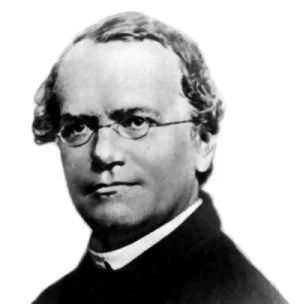Gregor Mendel
1822-1884
Inheritance
Gregor Mendel was an Augustinian friar at St. Thomas' Abbey in Czechoslovakia. At the time of his experiments in the mid-1800s, traits in children were thought to be inherited by "blending" those of the parents. Mendel did meticulous experiments with peas to disprove that notion. Instead, he showed that various characteristics, for example pea color and pea shape, were inherited discreetly and independently according to rules of dominant and recessive inheritance. He showed that there were two types of peas showing any dominant trait: purebred and hybrid. Peas showing the recessive trait were always purebred for that trait. When cross-breeding a purebred dominant plant with a purebred recessive plant, all offspring showed the dominant trait. However, when crossbreeding two of these offspring, three-quarters of the subsequent offspring would show the dominant trait and one-quarter would show the recessive trait. There was never any "blending" of the traits in the offspring. He determined from these and other experiments that each trait had two forms of discreet units of inheritance: a dominant unit and a recessive unit. Hybrids always appeared to have the dominant trait, but still were able to pass on the recessive unit to one-half of their offspring.
Mendel's rules of inheritance were largely ignored, ridiculed and even forgotten during his lifetime. It wasn't until the early 1900s that his work was re-discovered. The "units" of inheritance were then given the name of "genes" by the Danish botanist, Wilhelm Johannsen. These genes were contained in particles called "chromosomes" contained in the nuclei of Eukaryote organisms which include all plants and animals.
We now know that Mendel's purebreds were homozygous for the dominant trait whereas his hybrids were heterozygous for the trait. Since both the heterozygous and homozygous dominant plants appear to have the dominant trait, we call this appearance the "phenotype" of the plant. Plants having the recessive phenotype were always homozygous for the recessive trait. The genotype describes the actual genes so that the purebred dominant phenotype has a genotype containing two copies of the the dominant gene—one from each parent. The hybrid dominant phenotype would have one copy of each gene type, again one from each parent. The recessive phenotype would always contain two copies of the recessive form of the gene—one from each parent. Each of the genetic traits is now called an "allele" in the genome.
Today we call this type of inheritance Mendelian inheritance or Mendelian genetics. Twentieth century statisticians, when reviewing Mendel's publications, basically concluded that his results might have been too good to be true. They seemed fudged to prove Mendel's theories rather than reflecting the normal range of error and variation usually found in natural experiments. That is, statistically speaking, mating two hybrids would not always give the exact ratio of 3/1 in offspring phenotypes as Mendel's data showed, but rather by random chance would have various results around those values. None-the-less, Mendel's ratios are correct and his basic rules still apply generally in genetics. But as you will see in reading the chapter on genetics in the book, this greatly oversimplifies how our genes work and is even somewhat misleading.
Click on links to other players in my journey below.
Ardi * Aubrey de Grey * Bill Joy * C. Owen Lovejoy * Carl Linneaus * Charles Darwin * CRISPR *
Daniel E. Koshland, Jr * Elizabeth Kolbert * Ernst Mayr * Eugene E. Harris * Gregor Mendel * Henry Markram *
Ian Tattersall * Jean-Baptiste Lamarck * John Markoff * Katherine Pollard * Kevin de Queiroz * Lucy *
McBrearty and Brooks * Miguel Nicolelis * Paul Allen * Paul Berg * R.A.Fisher * Scott Blois * Singularity *
Stephen Jay Gould * Svante Pååbo * Sydney Brenner * Terry Sejnowski * Theodosius Dobzhansky *
